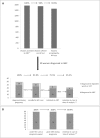Prevention of mother-to-child transmission of HIV Option B+ cascade in rural Tanzania: The One Stop Clinic model
- PMID: 28704472
- PMCID: PMC5507522
- DOI: 10.1371/journal.pone.0181096
Prevention of mother-to-child transmission of HIV Option B+ cascade in rural Tanzania: The One Stop Clinic model
Abstract
Background: Strategies to improve the uptake of Prevention of Mother-To-Child Transmission of HIV (PMTCT) are needed. We integrated HIV and maternal, newborn and child health services in a One Stop Clinic to improve the PMTCT cascade in a rural Tanzanian setting.
Methods: The One Stop Clinic of Ifakara offers integral care to HIV-infected pregnant women and their families at one single place and time. All pregnant women and HIV-exposed infants attended during the first year of Option B+ implementation (04/2014-03/2015) were included. PMTCT was assessed at the antenatal clinic (ANC), HIV care and labour ward, and compared with the pre-B+ period. We also characterised HIV-infected pregnant women and evaluated the MTCT rate.
Results: 1,579 women attended the ANC. Seven (0.4%) were known to be HIV-infected. Of the remainder, 98.5% (1,548/1,572) were offered an HIV test, 94% (1,456/1,548) accepted and 38 (2.6%) tested HIV-positive. 51 were re-screened for HIV during late pregnancy and one had seroconverted. The HIV prevalence at the ANC was 3.1% (46/1,463). Of the 39 newly diagnosed women, 35 (90%) were linked to care. HIV test was offered to >98% of ANC clients during both the pre- and post-B+ periods. During the post-B+ period, test acceptance (94% versus 90.5%, p<0.0001) and linkage to care (90% versus 26%, p<0.0001) increased. Ten additional women diagnosed outside the ANC were linked to care. 82% (37/45) of these newly-enrolled women started antiretroviral treatment (ART). After a median time of 17 months, 27% (12/45) were lost to follow-up. 79 women under HIV care became pregnant and all received ART. After a median follow-up time of 19 months, 6% (5/79) had been lost. 5,727 women delivered at the hospital, 20% (1,155/5,727) had unknown HIV serostatus. Of these, 30% (345/1,155) were tested for HIV, and 18/345 (5.2%) were HIV-positive. Compared to the pre-B+ period more women were tested during labour (30% versus 2.4%, p<0.0001). During the study, the MTCT rate was 2.2%.
Conclusions: The implementation of Option B+ through an integrated service delivery model resulted in universal HIV testing in the ANC, high rates of linkage to care, and MTCT below the elimination threshold. However, HIV testing in late pregnancy and labour, and retention during early ART need to be improved.
Conflict of interest statement
Figures



Similar articles
-
The challenge of referring HIV-positive pregnant women with treatment indication from PMTCT to ART services: a retrospective follow-up study in Mbeya, Tanzania.AIDS Care. 2014;26(7):850-6. doi: 10.1080/09540121.2013.869535. Epub 2013 Dec 20. AIDS Care. 2014. PMID: 24359539
-
Towards elimination of mother-to-child transmission of HIV in Ghana: an analysis of national programme data.Int J Equity Health. 2016 Jan 13;15:5. doi: 10.1186/s12939-016-0300-5. Int J Equity Health. 2016. PMID: 26759248 Free PMC article.
-
Prevention of mother-to-child transmission of HIV in rural Uganda: modelling effectiveness and impact of scaling-up PMTCT services.Glob Health Action. 2015 Feb 27;8:26308. doi: 10.3402/gha.v8.26308. eCollection 2015. Glob Health Action. 2015. PMID: 25726836 Free PMC article.
-
Uptake of guidelines on prevention of mother-to-child transmission of HIV in rural Tanzania: time for change.Swiss Med Wkly. 2013 Mar 14;143:w13775. doi: 10.4414/smw.2013.13775. eCollection 2013. Swiss Med Wkly. 2013. PMID: 23519621 Review.
-
Early retention among pregnant women on 'Option B + ' in urban and rural Zimbabwe.AIDS Res Ther. 2021 Apr 1;18(1):10. doi: 10.1186/s12981-021-00333-3. AIDS Res Ther. 2021. PMID: 33794957 Free PMC article. Review.
Cited by
-
The impact of Option B+ on mother-to-child transmission of HIV in Africa: A systematic review.Trop Med Int Health. 2022 Jun;27(6):553-563. doi: 10.1111/tmi.13756. Epub 2022 May 29. Trop Med Int Health. 2022. PMID: 35477948 Free PMC article.
-
Retention of HIV infected pregnant and breastfeeding women on option B+ in Gomba District, Uganda: a retrospective cohort study.BMC Infect Dis. 2018 Oct 24;18(1):533. doi: 10.1186/s12879-018-3450-9. BMC Infect Dis. 2018. PMID: 30355356 Free PMC article.
-
The Chronic Diseases Clinic of Ifakara (CDCI)-Establishing a Model Clinic for Chronic Care Delivery in Rural Sub-Saharan Africa.Diseases. 2022 Sep 30;10(4):72. doi: 10.3390/diseases10040072. Diseases. 2022. PMID: 36278571 Free PMC article.
-
Using a cascade approach to assess condom uptake in female sex workers in India: a review of the Avahan data.BMC Public Health. 2018 Jul 20;18(1):897. doi: 10.1186/s12889-018-5842-6. BMC Public Health. 2018. PMID: 30029597 Free PMC article.
-
Improving communication about HIV prevention among people living with HIV and their at-risk social network members in Dar es Salaam, Tanzania.Cogent Med. 2019;6:1600230. doi: 10.1080/2331205X.2019.1600230. Epub 2019 Mar 31. Cogent Med. 2019. PMID: 31355302 Free PMC article.
References
-
- UNAIDS. UNAIDS report on the global AIDS epidemic 2010. Joint United Nations Programme on HIV/AIDS (UNAIDS), Geneva, Switzerland; 2010. [Internet]. 2010 [cited 2017 Jan 18]. Available from: http://www.unaids.org/globalreport/documents/20101123_GlobalReport_full_...
-
- WHO. Use of antiretroviral drugs for treating pregnant women and preventing HIV infection in infants. World Health Organization, Geneva, Switzerland; 2004. [Internet]. 2004 [cited 2017 Jan 18]. Available from: http://www.who.int/hiv/pub/mtct/en/arvdrugswomenguidelinesfinal.pdf?ua=1
-
- WHO. Use of antiretroviral drugs for treating pregnant women and preventing HIV infection in infants. World Health Organization, Geneva, Switzerland; 2012. [Internet]. 2012 [cited 2017 Jan 18]. Available from: http://apps.who.int/iris/bitstream/10665/70892/2/WHO_HIV_2012.6_eng.pdf
-
- UNAIDS. Children and HIV. Factsheet July 2016. Joint United Nations Programme on HIV/AIDS (UNAIDS), Geneva, Switzerland; 2016. [Internet]. 2016 [cited 2017 Jan 18]. Available from: http://www.unaids.org/sites/default/files/media_asset/FactSheet_Children...
-
- Tanzanian MoHSW. National guidelines for comprehensive care services for prevention of mother-to-child transmission of HIV and keeping their mothers alive. Ministry of Health and Social Welfare, Dar es Salaam, United Republic of Tanzania; 2013. [Internet]. 2013 [cited 2016 Dec 1]. Available from: http://pmtct.or.tz/wp-content/uploads/2013/10/tz_guidelines_ccs_optionb_...
MeSH terms
Substances
LinkOut - more resources
Full Text Sources
Other Literature Sources
Medical

